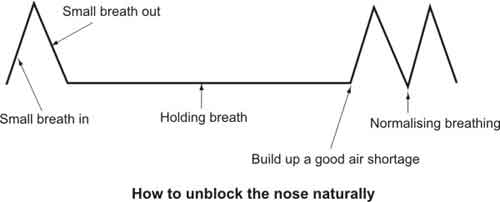Learn To Breathe Through Your Nose
While this exercise is perfectly safe for the vast majority of people, if you have any cardiac problems, high blood pressure, are pregnant, have type 1 diabetes, panic attacks or any serious health concern, then please do not hold your breath beyond the first urges to breathe. The following exercise is also very effective for decongesting your nose in just a few minutes:
- Sit up straight.
- Take a small breath in through your nose and a small breath out. If your nose is quite blocked, take a tiny breath in through the corner of your mouth.
- Pinch your nose with your fingers and hold your breath. Keep your mouth closed.
- Gently nod your head or sway your body until you feel that you cannot hold your breath any longer.
- When you need to breathe in, let go of your nose and breathe gently through it, in and out, with your mouth closed.
- Calm your breathing as soon as possible.

Repeat this exercise several times in succession, waiting about 30 to 60 seconds in between rounds. Be sure to do it on a regular basis, ideally daily. The fastest way to increase your CP is by learning to be mindful of your breathing on a moment-to-moment basis:
- Always keep your mouth closed for breathing, even during exertion. If you’re exercising or exerting yourself to the point you have to open your mouth to gasp for air, slow down and avoid exerting yourself beyond the point where you can no longer breathe through your nose. This will help you avoid the hazards associated with overbreathing during exercise, such as doing damage to your heart.
- Even when you breathe through your nose, try to breathe more lightly than you normally do; you should not be able to see your breathing in your chest or abdomen.
- Control your breathing all of the time, especially in stressful situations.
Additional Resources
According to McKeown, most dysfunctional breathing patterns are rooted in the modern lifestyle. Contributing factors include:
Addressing these issues can also be helpful if you struggle with chronic overbreathing or mouth breathing. To learn more about the Buteyko Breathing Method, check out McKeown’s books, “The Oxygen Advantage,” “Close Your Mouth: Self Help Buteyko Manual,” and “Anxiety Free: Stop Worrying and Quieten Your Mind,” which can be found on amazon.com and ButeykoClinic.com. There’s also a website dedicated to children, called ButeykoKids.com.
Sources and References
- 1 Eur Arch Otorhinolaryngol. April 2011, Volume 268, Issue 4, pp 533-539
- 2 Int Arch Allergy Immunol. 2011;156(4):352-61
- 3 Thoraz 2003 Feb;58(2):175-82
- 4 Nobelprize.org, Nobel prize in Medicine and Physiology 1998
- 5 Science.1992 Dec 18;(258(5090)):1862-5
- 6 Eur J Pharmacol.1992 Jan 14;(210(2)):221-2
- 7 J Appl Physiol. 1995 Sep; 79(3): 892-901
- 8 Med J of Australia 1998; 169: 575-578
- 9 British Journal Clinical Pharmacology. May; 29(5): p.519-524
- 10 Heart. May 1990: 63; 281-283
- 11 Chest October 1998; 114; 1083-1090
- 12 Eur J Cardiovasc Prev Rehabil. June 2004;11(3):223-7
- 13 Respiratory Physiology & Neurobiology 160 (2008) 123–130
- 14 Turkish Journal of Sport and Exercise. Year: 2016 – Volume: 18 – Issue: 1 – Pages: 17-24
- 15 European Journal Applied Physiology 2005 Oct;95(2-3):172-8
- 16 Rev Invest Clin 1989 Jul-Sep; 41(3):209-13
- 17 Thorax 1975; 30():337-343
- 18 Respiratory Physiology Neurobiology 2009 May 30;(167(1):20-5
The post Learn To Breathe Through Your Nose appeared first on LewRockwell.

Leave a Reply